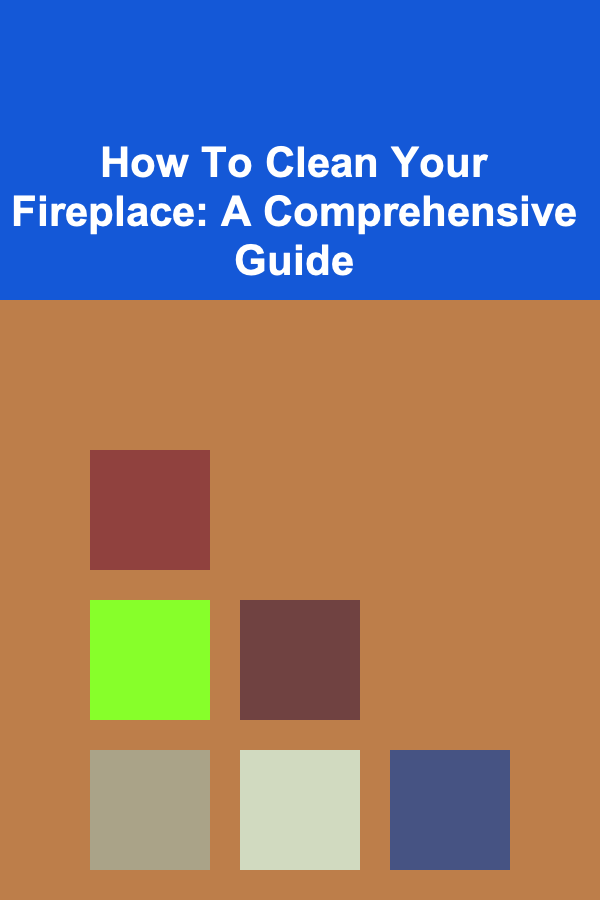
How To Clean Your Fireplace: A Comprehensive Guide
ebook include PDF & Audio bundle (Micro Guide)
$12.99$6.99
Limited Time Offer! Order within the next:

A crackling fireplace is a quintessential symbol of warmth and comfort, especially during the colder months. However, enjoying the ambiance of a fire comes with the responsibility of maintaining your fireplace. Regular cleaning isn't just about aesthetics; it's crucial for safety and efficiency. Creosote buildup, a byproduct of burning wood, is highly flammable and can lead to dangerous chimney fires. Furthermore, a clean fireplace burns more efficiently, providing better heat and saving you money on fuel. This comprehensive guide will walk you through the steps of cleaning your fireplace thoroughly and safely, covering everything from preparation to disposal.
Why Cleaning Your Fireplace is Essential
Ignoring the cleaning of your fireplace can have serious consequences. Understanding the dangers involved will highlight the importance of regular maintenance.
- Fire Hazard: Creosote buildup is the primary concern. Creosote is a tar-like substance formed when wood burns incompletely. It condenses on the inner walls of the chimney and is extremely flammable. Even a small spark can ignite creosote, leading to a chimney fire that can quickly spread to the rest of your home. There are three stages of creosote, with stage three being the most dangerous, characterized by a glazed, hard deposit that is very difficult to remove.
- Reduced Efficiency: A buildup of soot and ash restricts airflow, making your fireplace less efficient. This means you'll need to burn more wood to achieve the same level of heat, increasing your fuel costs. The restricted airflow also affects the draft, potentially causing smoke to back up into your house.
- Smoke Backdraft: A blocked chimney can cause smoke to be drawn back into your home, which is both unpleasant and unhealthy. Smoke contains harmful particles that can irritate your lungs and exacerbate respiratory conditions. Carbon monoxide poisoning is also a serious risk associated with poor ventilation.
- Structural Damage: Creosote is acidic and can corrode the lining of your chimney over time, leading to structural damage. This can be expensive to repair and can compromise the safety of your chimney.
- Unpleasant Odors: A dirty fireplace can emit unpleasant odors, especially during humid weather. The smell of stale ash and creosote can permeate your home and detract from the overall ambiance.
When to Clean Your Fireplace
The frequency of cleaning depends on how often you use your fireplace. However, it's generally recommended to clean your fireplace at least once a year, preferably before the start of the heating season. If you use your fireplace frequently (more than a few times a week), you may need to clean it more often, perhaps every 6 months. Here are some indicators that your fireplace needs cleaning:
- Visible Creosote Buildup: If you can see a significant layer of black, tarry substance on the inner walls of your chimney, it's time to clean. Use a poker or other tool to scrape a small area. If the creosote is more than 1/8 inch thick, it needs to be removed.
- Reduced Draft: If you notice that your fireplace is not drawing smoke as well as it used to, it could be a sign of a clogged chimney.
- Smoke Backdraft: If smoke is frequently entering your home when the fireplace is in use, it's a clear indication of a blockage.
- Odd Smells: A persistent smoky or tarry smell, even when the fireplace is not in use, can indicate creosote buildup.
- After Burning 3 Cords of Wood: A general rule of thumb is to have your chimney inspected and cleaned after burning approximately 3 cords of wood.
Tools and Materials You'll Need
Before you begin cleaning, gather all the necessary tools and materials. This will make the process more efficient and ensure you have everything you need on hand.
- Drop Cloths or Old Sheets: Protect your flooring and furniture from soot and ash.
- Stiff Brush: A fireplace brush with stiff bristles is essential for scrubbing the firebox and removing soot.
- Small Shovel or Scoop: For removing ash from the firebox. A metal scoop works best.
- Metal Bucket or Ash Container: To safely dispose of the collected ash. Make sure it has a tight-fitting lid.
- Shop Vacuum: A shop vacuum with a HEPA filter is ideal for cleaning up fine dust and ash. A regular household vacuum is not recommended, as it can clog the filter and spread dust.
- Protective Gear:
- Dust Mask or Respirator: Protect your lungs from inhaling harmful particles.
- Gloves: Protect your hands from dirt and grime.
- Eye Protection (Goggles): Prevent dust and ash from getting into your eyes.
- Old Clothes: Wear clothes that you don't mind getting dirty.
- Spray Bottle with Water: Lightly misting the ash can help to reduce dust.
- Optional: Fireplace Cleaner: Specialized fireplace cleaners can help to remove stubborn stains and creosote.
- Optional: Chimney Sweep Rods and Brush: If you plan on cleaning the chimney yourself, you'll need chimney sweep rods and a brush that fits your chimney's flue. This is generally best left to professionals.
Step-by-Step Guide to Cleaning Your Fireplace
Follow these steps carefully to ensure a thorough and safe cleaning.
Preparation (Safety First!)
- Wait for a Cool Fireplace: Never attempt to clean a fireplace that is still warm. Allow at least 12-24 hours for the fireplace to cool completely after the last fire.
- Open Windows and Doors: Ensure adequate ventilation to minimize dust inhalation.
- Protect the Area: Cover the surrounding area with drop cloths or old sheets to protect your flooring and furniture. Pay particular attention to covering any carpets near the fireplace.
- Wear Protective Gear: Put on your dust mask or respirator, gloves, and eye protection.
- Remove Valuables: Remove any valuable items from the surrounding area that could be damaged by dust or soot.
Cleaning the Firebox
- Remove Grates and Andirons: Carefully remove the grates and andirons from the firebox. These can be cleaned separately with a stiff brush and water. Allow them to dry completely before replacing them.
- Remove Ash: Use a small shovel or scoop to remove the ash from the firebox and place it into the metal bucket or ash container. Be careful not to overfill the bucket. You can lightly mist the ash with water to reduce dust.
- Scrub the Firebox: Use the stiff brush to scrub the interior walls of the firebox, removing soot and creosote buildup. Pay particular attention to areas with heavy buildup. If necessary, use a specialized fireplace cleaner to loosen stubborn stains. Follow the manufacturer's instructions carefully.
- Vacuum the Firebox: Use the shop vacuum with a HEPA filter to vacuum up any remaining ash, soot, and debris from the firebox. Be thorough and reach into all corners.
- Clean the Grates and Andirons (if removed): Wash the grates and andirons with soapy water and a stiff brush. Rinse thoroughly and allow to dry completely before placing back in the firebox.
Cleaning the Fireplace Surround
The fireplace surround, the area immediately surrounding the firebox, can also accumulate soot and dust. Cleaning this area will improve the overall appearance of your fireplace.
- Dust the Surround: Use a soft cloth or brush to dust the fireplace surround. Be careful not to scratch the surface.
- Clean the Surround: Depending on the material of your fireplace surround, use an appropriate cleaning solution.
- Brick: A mixture of water and mild detergent can be used to clean brick. For tougher stains, you can use a specialized brick cleaner. Be sure to rinse thoroughly.
- Stone: Use a pH-neutral cleaner designed for stone. Avoid using acidic cleaners, as they can damage the stone.
- Wood: Use a wood cleaner and polish to clean and protect the wood surround.
- Tile: Use a tile cleaner and grout brush to clean the tile and grout.
- Wipe Dry: After cleaning the surround, wipe it dry with a clean cloth.
Cleaning the Damper
The damper is a metal plate located in the chimney that controls airflow. It's important to keep the damper clean and functioning properly to ensure efficient burning and prevent smoke backdraft.
- Locate the Damper: The damper is usually located just above the firebox.
- Open the Damper: Make sure the damper is fully open.
- Clean the Damper: Use a stiff brush to remove any soot and creosote buildup from the damper. You may need to use a small scraper to remove stubborn deposits.
- Check the Damper's Operation: Make sure the damper opens and closes smoothly. If it's stuck or difficult to move, lubricate the hinges with a heat-resistant lubricant. If it's damaged, it may need to be repaired or replaced.
Chimney Cleaning (Important Note!)
Important Warning: Cleaning the chimney flue itself is a more complex and potentially dangerous task. While it's possible to do it yourself, it's generally recommended to hire a professional chimney sweep. Chimney sweeps have the necessary tools, experience, and insurance to safely and effectively clean your chimney. Improper cleaning can damage the chimney and even lead to a fire.
If you choose to clean the chimney yourself, here's a brief overview of the process:
- Choose the Right Brush: Select a chimney brush that is the correct size and shape for your chimney flue.
- Assemble the Chimney Sweep Rods: Attach the brush to the end of a chimney sweep rod and gradually add more rods as you push the brush up the chimney.
- Clean the Chimney: Push the brush up and down the chimney, overlapping each stroke to ensure thorough cleaning.
- Remove Debris: Remove the debris that falls into the firebox.
- Consider Professional Inspection: Even if you clean the chimney yourself, it's a good idea to have a professional chimney sweep inspect it annually to check for any damage or potential problems.
Safe Ash Disposal
Proper ash disposal is crucial for preventing fires and protecting the environment.
- Cooling Period: Ensure the ash is completely cold before disposal. Embers can remain hot for days. Let the ash sit in the metal bucket with a tight-fitting lid for at least 24-48 hours.
- Double Bagging: Place the ash in a heavy-duty plastic bag and then place that bag inside another bag. This helps prevent dust from escaping.
- Disposal Options:
- Municipal Waste: Check with your local waste management company for their regulations regarding ash disposal. Some municipalities may have specific guidelines.
- Composting (with caution): Wood ash can be added to compost in small amounts, as it contains potash and other nutrients. However, it is alkaline and can raise the pH of your compost. Avoid adding ash from treated wood, charcoal briquettes, or painted wood. Only use ash from natural, untreated wood.
- Garden Use (with caution): Wood ash can be used to amend soil in gardens, as it can provide nutrients and raise the pH of acidic soils. However, use it sparingly and test your soil's pH before applying ash. Avoid using it near acid-loving plants. Again, only use ash from natural, untreated wood.
- Never Dispose of Hot Ash: Never dispose of hot ash in a trash can, compost pile, or anywhere near flammable materials. This can easily start a fire.
Tips for Preventing Creosote Buildup
While regular cleaning is essential, you can also take steps to minimize creosote buildup in the first place.
Pro Tip: Prevention is key! Following these tips will reduce creosote buildup and extend the time between necessary cleanings.
- Burn Seasoned Wood: Seasoned wood is wood that has been properly dried for at least 6-12 months. It has a lower moisture content, which means it burns hotter and cleaner, producing less creosote.
- Avoid Burning Softwoods: Softwoods, such as pine and fir, tend to produce more creosote than hardwoods, such as oak and maple. If you must burn softwoods, burn them in moderation and mix them with hardwoods.
- Burn Hot Fires: Hotter fires burn more efficiently and produce less creosote. Avoid smoldering fires.
- Ensure Adequate Airflow: Make sure your fireplace has adequate airflow to support proper combustion. Open the damper fully when the fireplace is in use.
- Have Your Chimney Inspected Annually: A professional chimney sweep can inspect your chimney for any damage or potential problems and provide recommendations for maintenance and cleaning.
- Consider Using a Chimney Cap: A chimney cap helps prevent rain, snow, and debris from entering the chimney, which can contribute to creosote buildup.
When to Call a Professional
While many homeowners can handle basic fireplace cleaning, there are situations where it's best to call a professional chimney sweep.
- Heavy Creosote Buildup: If you have a significant buildup of creosote that you can't remove with a brush and vacuum, it's best to call a professional.
- Chimney Damage: If you notice any cracks, loose bricks, or other damage to your chimney, it's important to have it inspected and repaired by a professional.
- Animal Nest Removal: Animals, such as birds and squirrels, can build nests in chimneys, blocking the flue and creating a fire hazard. A professional chimney sweep can safely remove these nests.
- Difficulty Cleaning: If you're uncomfortable cleaning the chimney yourself, or if you're unsure about any aspect of the process, it's always best to err on the side of caution and call a professional.
- Annual Inspection: Even if you clean your fireplace regularly, it's a good idea to have a professional chimney sweep inspect it annually to ensure it's in good working order.
Conclusion
Cleaning your fireplace is an essential part of home maintenance, ensuring the safety and efficiency of your heating system. By following the steps outlined in this guide and taking preventative measures, you can enjoy the warmth and ambiance of your fireplace without the risks associated with creosote buildup and other potential problems. Remember, if you're unsure about any aspect of the cleaning process, don't hesitate to call a professional chimney sweep. A clean and well-maintained fireplace is a safe and enjoyable addition to any home.

How to Make a Checklist for Updating and Refreshing Old Content
Read More
How to Make Money Online as a Customer Service Rep: 10 Actionable Ideas
Read More
How to Organize Your Closet Using a Color-Coding System
Read More
How to Organize Your Time Capsule by Year or Decade
Read More
How to Make Healthy & Flavorful Marinades
Read More
How to Discover Series with Mind-Bending Concepts
Read MoreOther Products

How to Make a Checklist for Updating and Refreshing Old Content
Read More
How to Make Money Online as a Customer Service Rep: 10 Actionable Ideas
Read More
How to Organize Your Closet Using a Color-Coding System
Read More
How to Organize Your Time Capsule by Year or Decade
Read More
How to Make Healthy & Flavorful Marinades
Read More